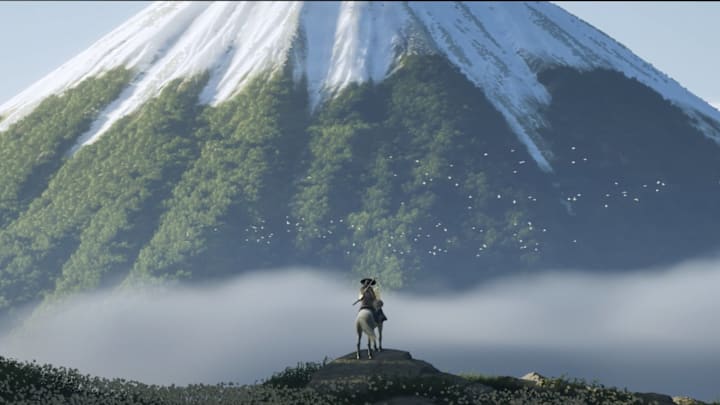Ghost of Yotei’s Watanabe Mode misses the magic of Samurai Champloo
By Dave Aubrey

When Ghost of Yotei’s Watanabe Mode was first announced, I said: “If I play that game, I’m going to use that mode.” It’s another mode in addition to the Kurosawa Mode inspired by Akira Kurosawa in Ghost of Tsushima – which added a grayscale filter to the action – and Yotei’s other new Miike mode, which adds gore and a tighter framing to mimic Takashi Miike’s iconic action movies. While a few simple filters and effects can’t truly replicate the feel of action directed by these two filmmaking giants, the new Watanabe Mode is a bit different.
Shinichiro Watanabe isn’t best known for live-action movies like Miike and Kurosawa; instead, his name is most often associated with Cowboy Bebop, an anime cult classic with a strong fusion of spaghetti Western and sci-fi aesthetics with an upbeat, jazzy soundtrack. It’s a unique blend that helped it stand out and become as iconic as it is today, but Watanabe’s Samurai Champloo doesn’t get the same kind of respect, despite absolutely being deserving of it.
Samurai Champloo is another unusual fusion, this time clashing old-school samurai aesthetics with what was – at the time – the emerging musical genre of lofi hip-hop. These unique blends have seen both series become cultural touchstones for the anime community, but Samurai Champloo’s influence stretches even further.
Nujabes – real name Jun Seba – is known as the godfather of lofi hip-hop, and it’s at least partially because of Samurai Champloo and the theme song Battlecry. The haunting, equalized tones combine with an iconic drum loop and a unique rapper – frequent Nujabes collaborator and multilingual artist Shing02 – to create one of the most quietly influential songs in all of hip-hop, and the series as a whole cemented a link between this emerging sound and the anime and comic geeks of the world. It certainly didn’t hurt that the Dr. Doom-inspired MF Doom and Madlib album Madvillainy launched the same year as Samurai Champloo, either. Nujabes sadly passed away in 2010 at the age of 36 after leaving an enduring legacy.
Samurai Champloo’s soundtrack wasn’t a one-man show by any means. Nujabes didn’t compose it alone, and worked with Shakkazombie’s Tsutchie, Fat Jon, and Force of Nature, further bridging the gap between the American hip-hop scene and the experimental scene in Japan. It was all brought together by Shinichiro Watanabe and the animators at Manglobe, who worked to fuse the tempos and beats of the soundtrack into the action seamlessly, as if the warriors strive to stay on beat.
When Sucker Punch announced that Watanabe would be directing the Watanabe Mode, it made me cautiously optimistic. It didn’t mean that the sounds that made Samurai Champloo the dramatic cult classic it is would be there, but it did mean that Watanabe would at least be selecting the sounds that best evoke the same atmosphere and vibes of Samurai Champloo.
When exploring the world in Yotei, it works. Riding through gorgeous, grassy fields atop your horse as 24-hour lofi beats to study and relax to play in the background is absolutely a vibe, and while one particularly echo-y melody grated, the rest of the tracks set the scene nicely, and the game is inextricably linked to that music in my mind. That’s a success story.
But when in battle, it all falls apart. Samurai Champloo’s stylish action – some of which was even inspired by breakdancing – can’t quite be replicated in Ghost of Yotei (Atsu is more of a Jin than a Mugen, if you know what I mean), but the slick parries and movement can. It feels on point, and a more up-tempo track (maybe even with Shing02 doing a verse?) would’ve cemented Watanabe Mode as my recommended way to play. Instead, when in battle, the music lacks the distinct atmosphere and flavor the other tracks marinate in. It’s hip-hop inspired, sure, but sadly forgettable.
The beautiful, hand-animated artwork of two feudal warriors clashing blades as a more contemporary rap beat played in perfect sync was exactly what made Samurai Champloo so good. Yes, I love the lofi beats during downtime – both in Ghost of Yotei and Samurai Champloo – but without a suitable accompanying battle track (maybe even a few, I’m greedy) it doesn’t capture the magic it’s trying to mimic.
I still recommend playing Ghost of Yotei in Watanabe Mode – if you already knew any info in my lofi history lesson, then it’s definitely for you – but without the complete package, it just didn’t feel like the game was made for it. I mean, it’s evidently not, but if a third Ghost game is on the horizon, I hope Sucker Punch nails it next time.
feed